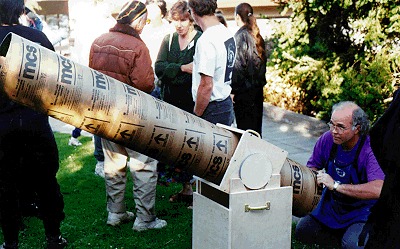Make a telescope
Build a simple telescope from cardboard tubes and lenses, then observe the Moon and nearby objects to explore magnification and basic optics.



Step-by-step guide to build a simple cardboard-tube telescope
My Super Spyglass! Looking Far with a Telescope! How Telescopes Work? Discover Space for Kids!
Step 1
Gather all the materials on a clear table with an adult nearby
Step 2
Measure the large tube to about 30 centimeters and cut it with scissors using adult help
Step 3
Measure the small tube to about 25 centimeters and cut it so it can slide inside the large tube
Step 4
Line the inside of both tubes with black construction paper and glue it in place
Step 5
Center and tape the larger focal length lens to one end of the large tube using masking tape
Step 6
Center and tape the shorter focal length lens to one end of the small tube using masking tape
Step 7
Insert the small tube into the large tube until there is about a two centimeter overlap
Step 8
Hold the eyepiece end to your eye and look at a distant object during the day
Step 9
Slowly slide the small tube in and out until the distant object appears clear
Step 10
Mark the tube position where the image is sharp with your marker
Step 11
Place a small strip of masking tape at the mark to hold the focus position
Step 12
Go outside at night when the Moon is visible
Step 13
Point the objective end of the telescope at the Moon
Step 14
Look through the eyepiece and fine tune the focus by sliding the tubes until the Moon looks sharp
Step 15
Share a photo or a description of your finished telescope and what you saw on DIY.org
Final steps
You're almost there! Complete all the steps, bring your creation to life, post it, and conquer the challenge!


Help!?
What can we use instead of the larger and shorter focal length lenses or black construction paper if those are hard to find?
Substitute two magnifying glasses of different strengths for the larger focal-length objective and the shorter focal-length eyepiece, and use black paint or black electrical tape in place of black construction paper while still lining the insides and taping the lenses as instructed.
The image stays blurry even after sliding the small tube—what might be wrong and how can we fix it?
Check that both lenses are centered and taped flat to the tube ends, the insides are dark from the black construction paper to prevent stray light, and the small tube can slide freely with about a two centimeter overlap—if it sticks or rubs, sand or trim the cut edges so it moves smoothly, then re-mark the sharp focus with the marker and masking tape.
How can we adapt this telescope activity for a 4–6 year old versus a 10–12 year old?
For 4–6 year olds have an adult measure and cut the large tube to ~30 cm and the small tube to ~25 cm and pre-attach lenses while the child helps line the tubes and slides to focus, whereas 10–12 year olds can do the measuring and cutting with supervision, experiment with different lens combinations, and record their Moon observations to share on DIY.org.
How can we improve or personalize our telescope after building it?
Personalize and enhance it by painting the exterior, adding a smartphone holder over the eyepiece to photograph the Moon, mounting it on a simple tripod for steadier viewing, and labeling the focus mark with decorative tape before sharing a photo or description on DIY.org.
Watch videos on how to build a simple cardboard-tube telescope
Telescope for Kids | Learn About Science for Kids
Facts about basic optics and stargazing
♻️ You can build a working telescope from recycled cardboard tubes and a couple of lenses, making astronomy a hands-on, low-cost hobby for kids.
🔍 A simple refracting telescope works with two lenses: a large objective lens to collect light and a small eyepiece lens to magnify the view.
🌕 Even a small homemade telescope can reveal Moon features like craters and maria (the dark 'seas') — no observatory needed!
🔭 The first practical telescope design appeared in 1608, and Galileo used an improved version in 1609 to map the Moon and discover Jupiter’s moons.
📏 The magnification of a basic telescope is (focal length of the objective) ÷ (focal length of the eyepiece) — longer objective or shorter eyepiece = more zoom!
How do I build a simple cardboard tube telescope and observe the Moon?
What materials do I need to make a cardboard tube telescope?
What ages is a cardboard tube telescope suitable for?
What are the benefits of making and using a cardboard telescope with children?


One subscription, many ways to play and learn.
Only $6.99 after trial. No credit card required



